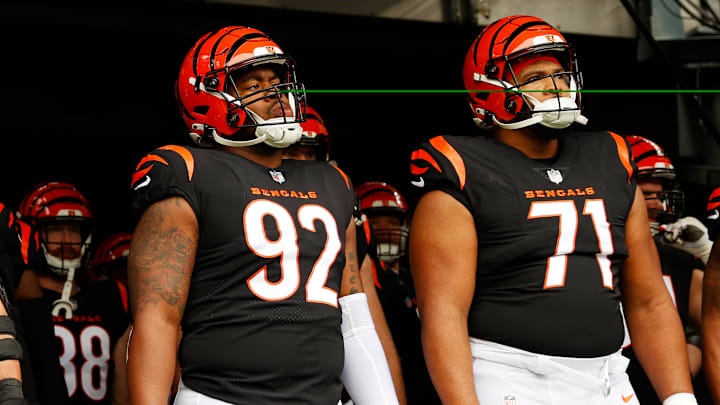The NFL offseason is full of speculation about who the Cincinnati Bengals might release to save cap space. Currently, the Bengals have a dead cap figure of less than $1M. Expect that number to increase over the next few weeks.
That is because, to create more cap space, the team will seek to offload salaries, resulting in an increased dead cap hit between $11M and $14M if the past three seasons are any indication. With that, we will try to surmise which four to five players could be released to get to that dead money total.
Simply put, “dead money” is the amount of money allocated to the salary cap for players who are no longer on the roster. This money is owed to players through guaranteed money and bonuses still owed to the player even though he has been released or traded. Currently, Tyler Shelvin accounts for $368,280 of the team’s $540,902 dead money figure.
Note: All salary cap numbers provided by Over the Cap.
Each of the past three seasons the Bengals have had dead cap totals of $13.4M (2020), $13,203,467M (2021), and $11.86M (2022) wrapped up in five players alone.
In 2020, Carlos Dunlap ($6,180,515), Dre Kirkpatrick ($2.8M), John Miller ($2.6M), Preston Brown ($1.6M), and BW Web ($1M) accounted for a$13.4M of a total dead cap number of $19.5M that season.
In 2021, the team accumulated $13,203,467 in dead money for Geno Atkins ($5.2M), Xavier Su’a-Filo ($3,103,921), Billy Price ($1,6495,546), and Bobby Hart ($1M) along with a carryover for Carlos Dunlap ($2.25M). The team spread out Dunlap’s cap hit over two years. In 2021, Cincinnati carried a total dead cap of $18.9M, $13M of which was for five players.
In 2022, the Bengals began the season with Trae Waynes ($5M), Riley Reiff ($2.75M), Mike Thomas ($1.135M), and Trey Hopkins ($1.125M) accounting for most of the dead cap total. Later, they added Kevin Huber’s $1.85M to the sum. Five players made up $11.86M of the total 15.8M in dead cap money.
Before we begin with the next part, none of this is to say that the following players should be released or traded. It is an attempt to match up possible dead cap money from this upcoming year as closely as possible to the past three years, while only including four or five players.
Joe Mixon, La’el Collins, and Tyler Boyd are names that have been thrown around as possible cap casualties so far this offseason. Mixon ($2.75M), Collins ($1.6M), and Boyd ($1.4M) would carry a total of $5.75M in dead cap space. The team would save $10M, $7.7M, and $8.9M, respectively, in cap space as post-June 1st cuts.
Collins’ dead cap number could increase if the team decides to move on. It would depend on his injury status. If Collins is not healthy enough to pass a physical before the Bengals released him, the two sides would have to reach an injury settlement. In that case, the team would not save as much cap space and would have to carry a larger dead money burden.
The closest number that could represent a Kirkpatrick, Atkins, Su’a-Filo, or Waynes-type impact would be B.J. Hill. His dead money would be at $3.3M with a salary cap savings of $7.5M.
In total, parting ways with these four players would save $34.1M in cap space, but would carry a $9.05M dead cap bill. However, if the past three seasons are any indication, that dead money total number could fall somewhere between $11M and $13.5M, without adding more than one more player.
However, deciding which one of these following players the team would let go for salary cap issues seems impossible. Trey Hendrickson ($2.5M), Sam Hubbard ($2M), Chidoe Awuzie ($1.5), Mike Hilton ($1M), Ted Karras ($1M), and D.J. Reader ($4M) are the only other guys who could go on this list. Do not count on the Bengals parting with any of these guys this off-season.
They could also reach that $11M figure if they part ways with Collins and have to carry money over from an injury settlement. That would also mean that the team will be in the market for a starting right tackle two years in a row.
The offseason is always a fun time to speculate and try to predict what your favorite team will look like next year. Part of that is knowing how the organization uses the salary cap. Clearly, the Bengals have a range in which they feel comfortable operating as far as dead money is concerned.
Hopefully, the team can add to an already loaded roster without reaching that $11M mark in dead money this offseason. If so, they will have been able to retain most of their best players while being able to add talent through free agency with their $35M in cap space they currently have available.
Another option is to restructure current deals to create cap space. The risk for the team is that could create a situation in the future where dead money becomes crippling and lead to some lean years as far as talent acquisition is concerned. This is a problem the Bengals never run into because of the way they are able to keep dead money under control.
However things play out, let’s hope the Bengals make all the right moves so they can make another run to the Super Bowl.
We love the Bengals 3,000. Who Dey?!
